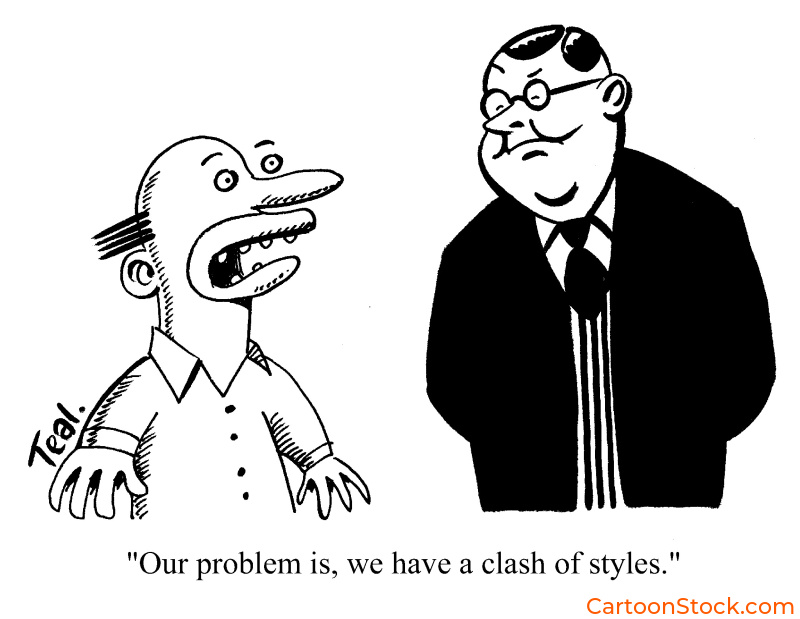Part of our History & Art of Cartoons guide
Style Is Everything
Cartoons might be famous for their wit, but it’s their style that sticks in people’s minds. One look at a thickly inked dog with wild eyes or a spare, captioned New Yorker panel—and you know exactly what you’re looking at.
The most recognizable cartoon styles don’t just entertain. They shape perception, define brands, and even influence what people buy, share, and save. Style is shorthand for tone, audience, and meaning—and for cartoonists, it’s as essential as the punchline.
What Makes a Cartoon Style?
When we talk about cartoon style, we’re referring to much more than drawing ability. It includes:
-
Line quality (smooth, jagged, thick, loose)
-
Use of color (vibrant, muted, monochrome)
-
Character design (proportions, expressions, visual quirks)
-
Lettering and layout (handwritten vs. digital, speech bubbles vs. captions)
Some styles are whimsical and childlike. Others are dry and austere. Either way, a cartoon’s visual identity has a huge impact on how the message is received.
Cartoon Styles That Defined Eras (and Platforms)
Let’s look at a few of the most enduring cartoon styles—and how they came to be so distinctive.
The New Yorker Line Art Style
Clean. Minimal. Ironic.
Since 1925, The New Yorker has set the gold standard for subtle, cerebral cartooning. These black-and-white panels often rely on sparse visuals, clever composition, and even cleverer captions.
Their style has become so iconic that even visual parodies of it are instantly recognized. It’s the kind of aesthetic that says: “Yes, this is a cartoon. But don’t expect slapstick.”
It’s also one of the most sought-after in the collector’s market. You can see why in Cartoon Collecting: The Rise of Cartoons as Valuable Art.
The Gag Panel Exaggeration Style
Think wild eyebrows, flailing limbs, and punchlines delivered mid-chaos.
This bold, expressive style is common in syndicated gag panels, greeting cards, and legacy publications. It’s designed to grab attention fast and telegraph the joke in a single glance.
These cartoons are loud on purpose. Their exaggerated expressions and highly active compositions are ideal for universal humor—and excellent for licensing in workplace or editorial settings.
Modern Flat-Style Cartoons
Slick, digital, and platform-friendly.
These cartoons use bold outlines, flat color fills, and a simplified aesthetic that works perfectly on mobile screens. You’ve seen them on Instagram slides, explainer sites, and web comics.
Flat-style cartoons are versatile and scale well across platforms—making them a favorite in marketing and digital education. They’re modern, accessible, and optimized for shareability.
The Hand-Drawn Sketch Style
This style leans heavily into personal expression. Think irregular lines, hand-lettered captions, and slightly off-kilter figures that feel more diary than doodle.
Artists like Roz Chast and Liana Finck have made this look both intimate and wildly effective. Often used in observational humor or emotional storytelling, this style feels human—and intentionally imperfect.
Single-Color Editorial Cartoons
Symbolic. Stark. Serious.
Many editorial cartoonists use limited color (or none at all) to create bold, minimalist visuals that convey sharp social critique. These cartoons often use strong contrast, clever symbolism, and confident white space.
They’re powerful because they’re stripped down. Want a great example? Check out How Editorial Cartoons Have Shaped Social Commentary Beyond Politics.
Where These Styles Come From
Some cartoon styles emerged from necessity—print limitations, ink costs, or column widths. Others evolved from specific tools: dip pens, felt-tips, digital tablets, vector software.
But most are rooted in larger art movements:
-
The New Yorker style reflects mid-century modernism
-
Flat-style cartoons owe a debt to Bauhaus and minimalism
-
Sketch styles trace back to zines, underground comics, and diary art
The origins of these styles reveal how cartoons mirror the wider design world. What’s trending in visual culture almost always finds its way into the next wave of cartoons.
Why Recognizable Style Still Matters
In today’s sea of content, style isn’t just an artistic choice—it’s a brand asset.
Cartoonists with consistent, distinct styles are easier to follow, remember, and license. They’re also more likely to be collected or go viral. Readers may not always recall the cartoonist’s name, but they’ll recognize the style.
This is one of the biggest lessons in The Evolution of Cartoon Art: How Styles Have Changed Over Time, style evolves, but recognition is what makes it last.
Q&A: Recognizable Cartoon Styles
Q: What makes a cartoon style instantly recognizable?
A: It’s a combination of consistent visual elements—line, layout, color, and character—that sets one cartoonist apart from others.
Q: Can cartoonists blend multiple styles?
A: Definitely. Many develop hybrid styles or switch aesthetics depending on the topic or platform.
Q: Does style affect licensing or popularity?
A: Yes. Style influences how easily a cartoon can be matched to tone, brand, or audience—making it more attractive for syndication and reuse.
Style as Signature
Cartoon style isn’t just decoration. It’s storytelling shorthand. It tells us what kind of laugh we’re in for, how seriously to take the message, and who the cartoon is really for.
The most recognizable cartoon styles endure not because they’re trendy—but because they become a cartoonist’s signature. They’re instantly familiar. And they make the message stick.
Keep Reading
See how cartoon styles evolve across decades:
Read: The Evolution of Cartoon Art: How Styles Have Changed Over Time


